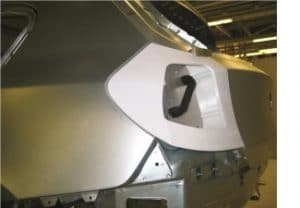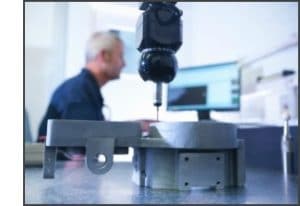Additive Manufacturing Makes Less Expensive Manufacturing Aids in Less Time
 Companies that succeed in manufacturing nearly always develop a wide range of manufacturing aids – custom tools that help manufacturing floor employees do various jobs faster, more accurately, with fewer steps, etc.
Companies that succeed in manufacturing nearly always develop a wide range of manufacturing aids – custom tools that help manufacturing floor employees do various jobs faster, more accurately, with fewer steps, etc.
For example, Diebold uses many different fixtures to hold small components while they are machined or assembled. Swift Engineering uses sacrificial internal tools to create hollow features in composite structures. BMW uses custom hand tools for attaching bumper supports as well as a wide range of other assembly and testing jobs.
The competitive advantage of manufacturing aids
These and tens of thousands of other tools provide a competitive advantage by enabling manufacturers to build, assemble and inspect their products in less time and at higher levels of quality. But manufacturing aids are usually needed in very small lot sizes, often only a single tool, which creates problems for traditional manufacturing methods.
As a case in point, Diebold found that producing fixtures using conventional manufacturing methods could easily take a week, sometimes delaying a product’s release. Swift previously used time-consuming, multi-piece bonded assemblies to create hollow features. BMW used conventional metal-cutting manufacturing methods that are expensive and time-consuming when used to make manufacturing jigs and fixtures in small lot sizes.
When to use additive manufacturing to produce manufacturing aids
 The time and cost involved in producing manufacturing aids using traditional manufacturing methods makes them hard to justify in many applications which means that production continues to run at less than optimal efficiency without them. To keep their cost at a reasonable level, engineers designing these tools often must compromise their design, such as by avoiding flowing organic shapes. Conventional manufacturing methods also tend to produce manufacturing aids that are relatively heavy, which may make them difficult to handle, especially for smaller and lighter workers.
The time and cost involved in producing manufacturing aids using traditional manufacturing methods makes them hard to justify in many applications which means that production continues to run at less than optimal efficiency without them. To keep their cost at a reasonable level, engineers designing these tools often must compromise their design, such as by avoiding flowing organic shapes. Conventional manufacturing methods also tend to produce manufacturing aids that are relatively heavy, which may make them difficult to handle, especially for smaller and lighter workers.
On the other hand, additive manufacturing produces manufacturing aids without requiring molds, tooling, or CNC programs, so small lot production is less expensive and can be completed in less time. This helps explain why Diebold, Swift Engineering, BMW and many other manufacturers use Stratasys Fused Deposition Modeling (FDM) additive manufacturing technology to produce manufacturing aids.
How companies are using FDM additive manufacturing technology
FDM builds manufacturing aids from durable thermoplastics to an accuracy of 0.005 inch. Additive manufacturing gives engineers complete freedom to produce manufacturing aids in virtually any geometry which often leads to productivity gains. The FDM sparse-fill build method can also be used to reduce the weight of manufacturing tools which makes them easier for workers to handle. The results speak for themselves:
- – Diebold uses a Stratasys Fortus FDM system to create assembly and machining fixtures in one-quarter the time and at one-half the cost of conventional machining.
- – Swift Engineering has reduced the time for composite tool build from four to six weeks to a few days or less.
- – BMW uses additive manufacturing to produce ergonomically-designed manufacturing aids that perform better than conventionally-made tools. In one application, BMW reduced the weight of an aid by 72% using the sparse-build method. BMW also takes advantage of the design freedom offered by additive manufacturing, in one case producing a tool for attaching bumper supports that features a convoluted tube that bends around obstructions and places fixturing magnets exactly where needed.
Manufacturing aids that can be more profitably produced with additive manufacturing
By reducing the cost and time required to produce manufacturing aids, additive manufacturing often makes it possible to expand the use of aids to many new applications. Here’s an overview of the main categories of manufacturing aids that can be more profitably produced with additive manufacturing:
- – Jigs and fixtures: Additive manufacturing enables manufacturers to produce a wide range of custom tooling for specific tasks, components, individuals and equipment at a fraction of the cost of conventional manufacturing methods. Typical examples include robot end-effector tooling, protective guards and covers, work-holding devices, measurement gauges, dunnage trays, and many others.
- – Composite tooling: Additive manufacturing makes it possible to produce molds and mandrels for composite tooling and sacrificial tooling for complex, trapped tool geometries in days rather than weeks while providing substantial cost reductions.
- – Molds: Manufacturers can reduce development time and risk by using additive manufacturing to produce molds that can be used to test and validate molded parts with the final production processes and materials. Examples include injection molds, blow molds and liquid silicone rubber molds.
- – Forming tools: Producing metal forming tools with additive manufacturing can reduce the time required to get from tool design to production to as little as week. Additive manufacturing can also be used to produce thermoforming tools for vacuum forming that will produce 100 to 1,000 parts.
- – Casting masters: Using additive manufacturing to produce wax patterns for investment casting offers substantial time and cost savings over traditional tooling methods. Additive manufacturing can also produce sand casting patterns, delivering substantial savings in cost, labor and time while speeding new product development.

 Blog
Blog